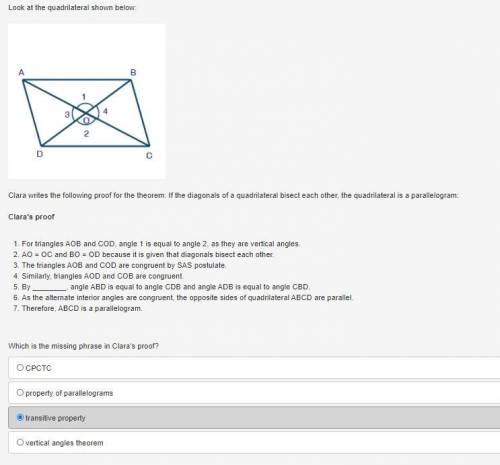
Mathematics, 16.12.2020 20:10 Savy8595
Look at the quadrilateral shown below:
A quadrilateral ABCD is shown with diagonals AC and BD intersecting in point O. Angle AOB is labeled as 1, angle BOC is labeled as 4, angle COD is labeled as 2, and angle AOD is labeled as 3.
Clara writes the following proof for the theorem: If the diagonals of a quadrilateral bisect each other, the quadrilateral is a parallelogram:
Clara's proof
For triangles AOB and COD, angle 1 is equal to angle 2, as they are vertical angles.
AO = OC and BO = OD because it is given that diagonals bisect each other.
The triangles AOB and COD are congruent by SAS postulate.
Similarly, triangles AOD and COB are congruent.
By _, angle ABD is equal to angle CDB and angle ADB is equal to angle CBD.
As the alternate interior angles are congruent, the opposite sides of quadrilateral ABCD are parallel.
Therefore, ABCD is a parallelogram.
Which is the missing phrase in Clara's proof?
CPCTC
property of parallelograms
transitive property
vertical angles theorem


Answers: 2
Another question on Mathematics

Mathematics, 21.06.2019 17:00
Acylinder and its dimensions are shown. which equation can be used to find v, the volume of the cylinder in cubic centimeters?
Answers: 1

Mathematics, 21.06.2019 22:10
Gravel is being dumped from a conveyor belt at a rate of 25 ft3/min, and its coarseness is such that it forms a pile in the shape of a cone whose base diameter and height are always equal. how fast is the height of the pile increasing when the pile is 14 ft high? (round your answer to two decimal places.) ft/min
Answers: 3

Mathematics, 21.06.2019 23:30
Drag each number to the correct location on the statements. not all numbers will be used. consider the sequence below. -34, -21, -8, 5, complete the recursively defined function to describe this sequence
Answers: 1

Mathematics, 22.06.2019 02:00
Acompany had forty one employees and ordered nine hundred eighty uniforms for them. if they wanted to give each employees the same number of uniforms, how many more uniforms should they order so they don't have any extra
Answers: 1
You know the right answer?
Look at the quadrilateral shown below:
A quadrilateral ABCD is shown with diagonals AC and BD inter...
Questions

Mathematics, 22.06.2019 12:30


Mathematics, 22.06.2019 12:30

Mathematics, 22.06.2019 12:30

Social Studies, 22.06.2019 12:30



History, 22.06.2019 12:30



Social Studies, 22.06.2019 12:30

History, 22.06.2019 12:30




Mathematics, 22.06.2019 12:30

Chemistry, 22.06.2019 12:30



Social Studies, 22.06.2019 12:30




